Sushi Zo (Los Angeles, CA)
Sushi Zo
9824 National Blvd, Los Angeles, CA 90034
310.842.3977
www.fooddigger.com/RestaurantDetail.aspx?id=21047 (FoodDigger, restaurant has no web site)
Sat 01/24/2009, 07:00p-09:20p
When asked about the best sushi in Los Angeles, most serious eaters (me included) will respond with Urasawa. In fact, I'm fairly confident that those who don't, simply haven't been. Now, given that Urasawa is at the top of the hierarchy, the question then of who's number two becomes more interesting. A lot of people would say Mori Sushi, some the infamous Sushi Nozawa, or perhaps Sushi Sasabune, maybe even Go's Mart, but the most common answer I hear is the topic of this post: Sushi Zo.
Chef/owner Keizo Seki (most just call him "Keizo") opened Sushi Zo in the middle of 2006, around the time when his daughter was born (a sign of good luck according to Seki-san). Keizo was a student in Osaka when he decided to become a sushi chef, and soon thereafter began an apprenticeship at a sushi restaurant in the Meguro ward of Tokyo. He later immigrated to the US, and spent several years at the dependable but unassuming Hide Sushi before branching out on his own.
Like many sushi greats, Keizo makes his own special shoyu, or soy sauce, and gets much of his raw ingredients shipped from Japan. He also subscribes to the somewhat controversial "warm rice" school, and indeed, on cursory glance, his style does bear a resemblance to the Nozawa/Sasabune way of doing things. No matter, Keizo must be doing something right, as he has drawn legions of followers from amongst the SoCal foodie crowd. It was time for me to see what all the warm fuss was about.
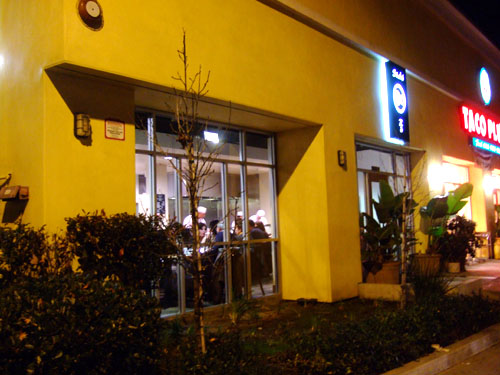
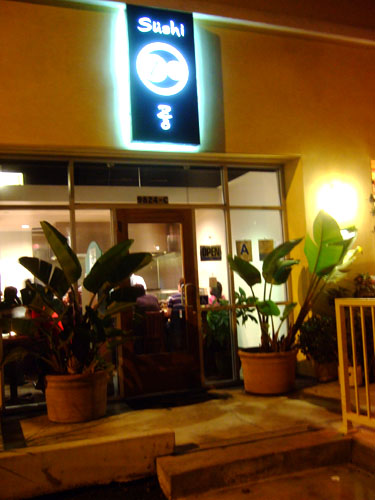
Set in a Rite-Aid- and Vons-anchored strip mall south of Cheviot Hills, Sushi Zo's location doesn't exactly inspire confidence, and would be very easy to overlook. Fortunately however, parking is plentiful and the restaurant is conveniently located for good freeway access.
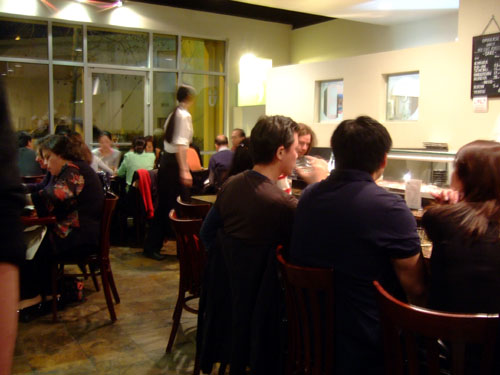
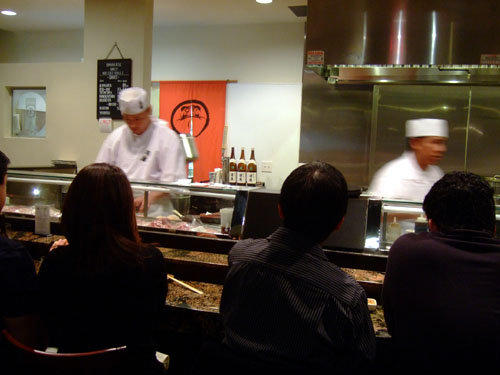
The interior is fairly contemporary for a sushi bar. No light wood here, but shades of alternating white and argent. From what I hear, the bar (which seats about a dozen) is omakase only, and on Fridays and Saturdays, the entire restaurant is. Not that you should order anything else but omakase...
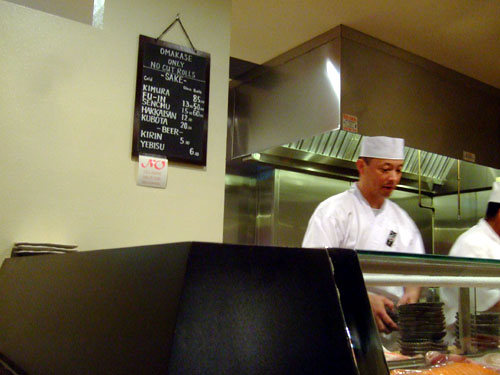
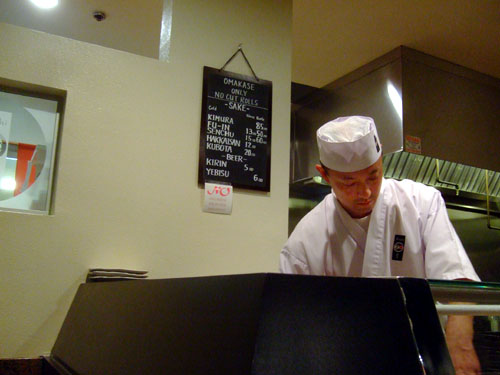
I was seated in the corner of the L-shaped bar, nearly right in front of Keizo. Once seated, our waitress warned us that the place served traditional sushi only and, once we agreed to that, asked about any food restrictions we might have ("I'll eat anything" is the correct answer here). There were three people behind the counter, and interestingly, though Keizo was right in front of us, he didn't actually place the individual pieces of sushi before us, instead, leaving that task to the waitresses (who also instructed us on the use of soy, e.g. "no soy" or "little soy"). Keizo is a man of few words, as he remained silent throughout most of the night, only gradually opening up towards the end of the experience.
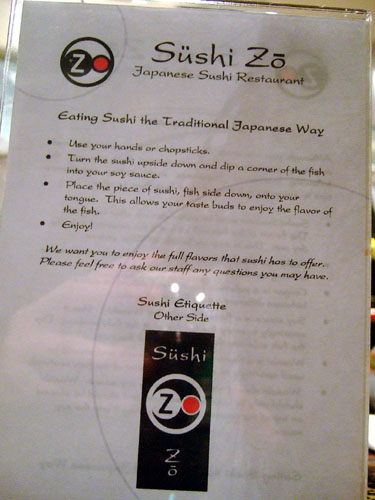
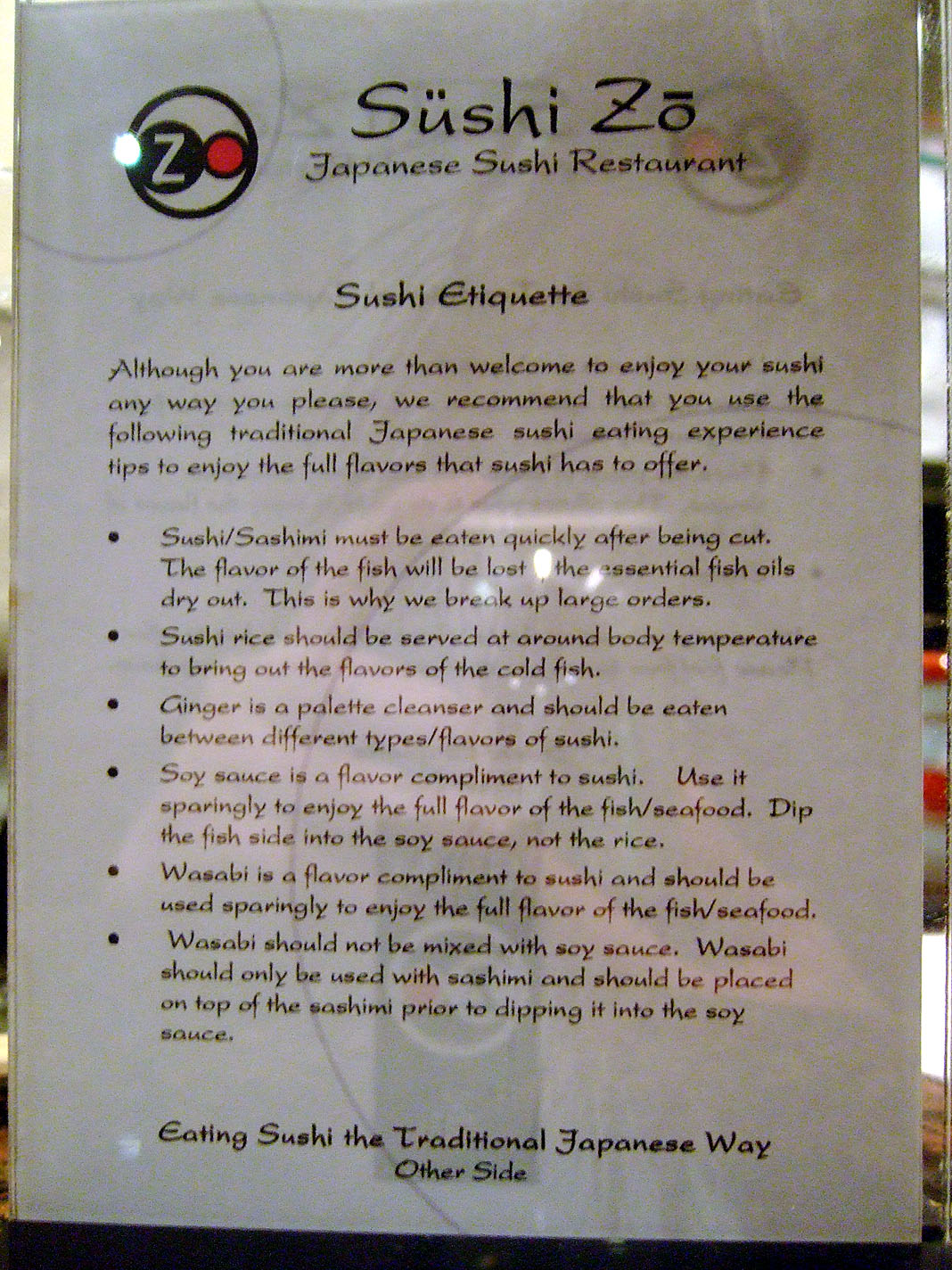
Placed on the bar were these placards bearing sushi-eating instructions and etiquette; click for larger versions. It's good advice, and though I don't see Keizo as being terribly strict, I have heard anecdotes of him kicking people out for trying to order California rolls and such, and also for talking on cell phones.
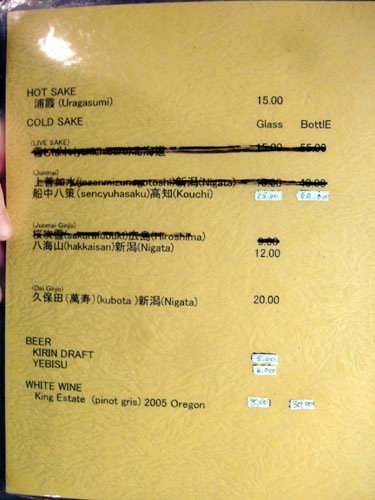
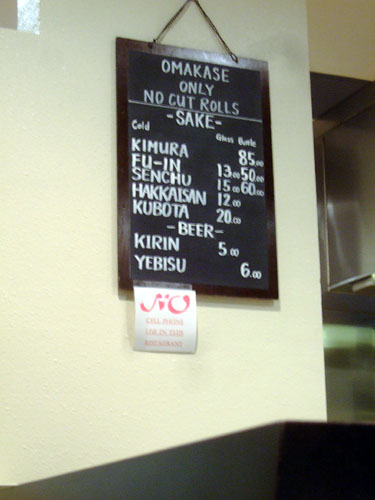
The drink menu is unfortunately small--just a couple beers, a solitary wine, and a handful of sakes are available. Some sparkling wine would be a welcomed addition for me.
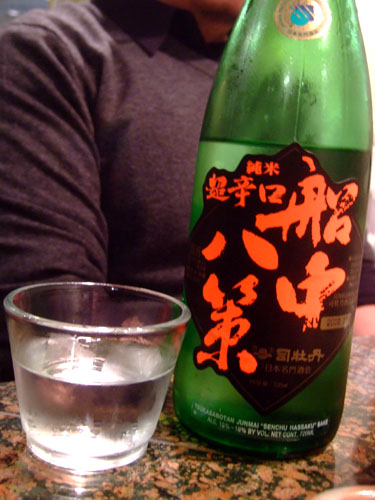
Given the limited selection, we decided to kick things off with sake: a bottle of Tsukasabotan Tokubetsu Junmai "Senchu Hassaku" ("Eight Point Plan") [$60.00]. Founded in 1603, the producer, Tsukasa Botan, is one of the oldest breweries in Kochi prefecture, on Shikoku island. The sake here is their mid-end selection, and is made from Yamada Nishiki rice polished to roughly 57%, resulting in an alcohol content in the 15.5% range. I noted a light airiness to the drink, with a mildly sweet and creamy aroma leading to a dry, yet fruity palate. Not overly complex, but effective, with a smooth, straightforward finish.
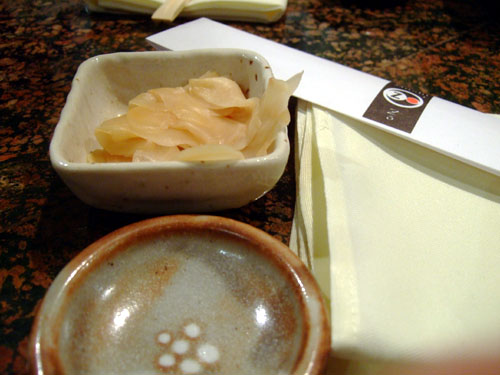
Here we see the place setting at the beginning of the meal. The gari, or ginger, was among the best I've tried--crisp, with a bracing tang that effectively reset the palate between courses.
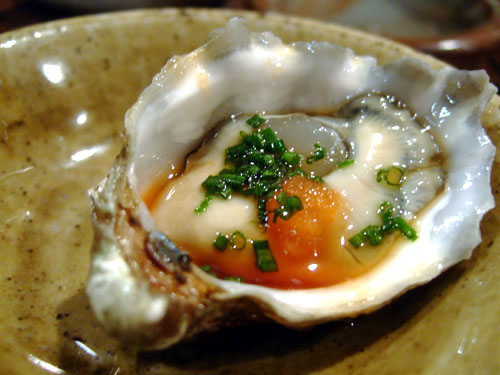
1: Kumamoto Kaki/Oyster [$2.80]
I've always been fond of Kumamotos, and this dish reaffirmed their status as my oyster of choice. The example here, heightened by the application of ponzu, momiji oroshi and scallion, was clean, light, crisp, and tangy, with a pleasant, lingering brininess on the finish.
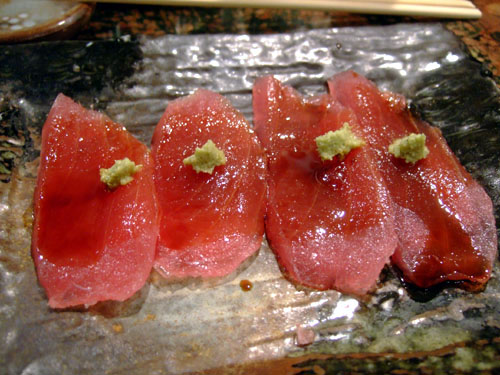
2: Maguro/Tuna Sashimi [$12.00]
Next, a simple sashimi course of bluefin tuna. This could've turned out very boring (as tuna tends to), but was actually a pleasant surprise. The maguro had a very pleasing texture to it--tender, yet with a bit of chew to it, and was suitably oily. The light sauce added complexity upon first taste, while the dollops of wasabi gave the sashimi a biting, spicy finish.
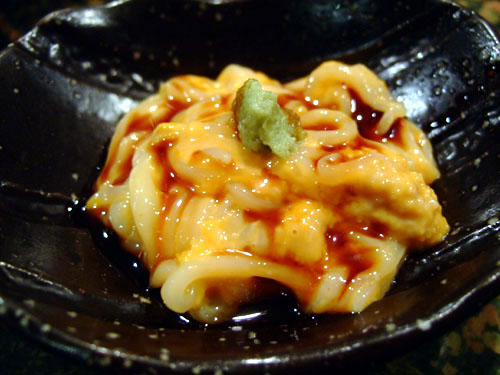
3: Ika/Squid Noodle with Uni/Sea Urchin [$6.00]
Now this was an interesting dish. What we have is squid "noodles" smothered in a creamy sea urchin roe "sauce." The uni really came to the fore here, with the squid taking a backseat. In fact, had I not been told of the squid, I could've easily mistaken the "noodles" for actual noodles, as they were very soft and not chewy at all.
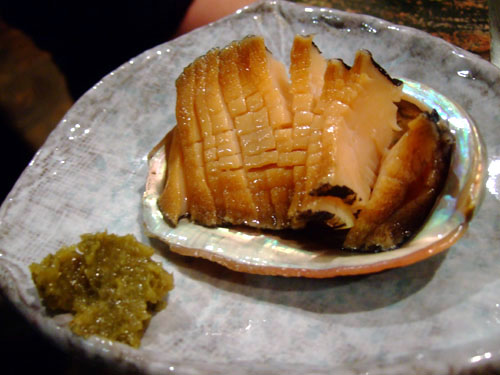
4: Awabi/Baby Abalone [$25.00]
The abalone itself was rather mild, with just a hint of brininess, and had a crunchy, slightly rubbery consistency. It wasn't particularly exciting on its own, but really opened up with the use of yuzu kosho ("yuzu and pepper"), a condiment made from yuzu zest, chili peppers, and salt. It added an absolutely fascinating spicy yet salty yet sour kick to the abalone that really took the dish to another level.
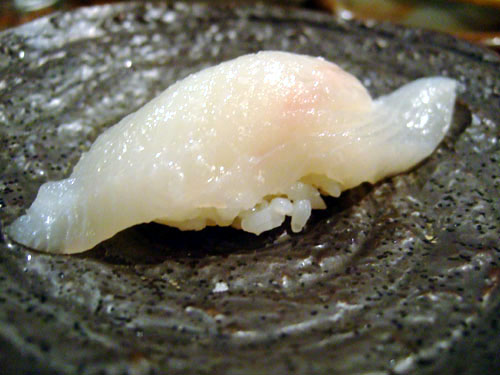
5: Hirame/Halibut [$2.60]
No soy. The hirame was a nice way to start off the nigiri portion of the meal. Halibut isn't particularly strong tasting, and initially, all I got was a sort of general fishiness spruced up by a very slight citrus-y twang, followed up by a wasabi kick. Gorgeous texture on this one.
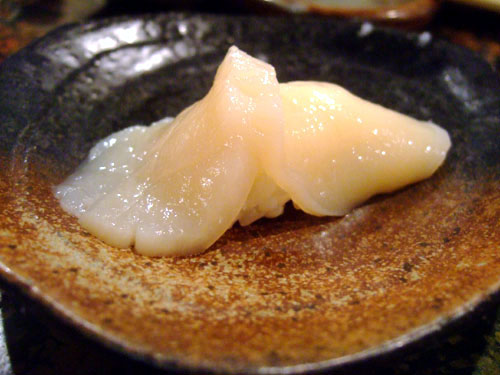
6: Hotate/Scallop [$2.70]
Little soy. A fantastic soft, yet firm texture along with a wonderfully delicate, sweet scallop flavor combined here to form one of the best preparations of scallop sushi I've had.
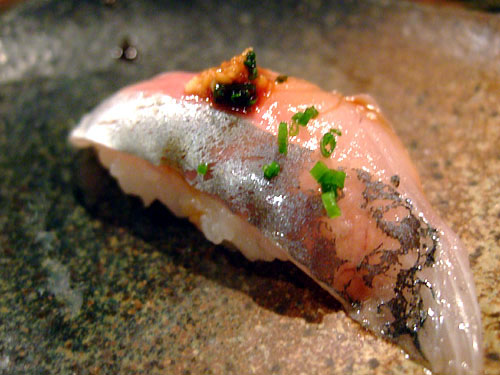
7: Aji/Spanish Mackerel [$2.70]
No soy. Aji is quickly becoming one of my favorite fishes, and this example shows why. There was just enough of that signature mackerel fishiness to make this interesting, but it didn't overpower like it sometimes does. Instead, the flavor was complemented perfectly by the tart sauce and strong ginger-y finish.
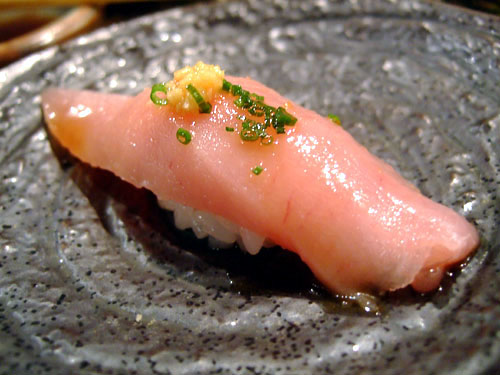
8: Ha-Gatsuo/Skipjack Tuna [$2.80]
No soy. Skipjack is a relatively rare fish to find; I've only had it before at Echigo and Urasawa. I wish it were more common, as it turned out to be one of the highlights of the evening. Much more fascinating than regular tuna, the fish had a somewhat softer, richer texture. The taste initially was dominated by ponzu and ginger, but gradually gave way to reveal the true nature of the fish.
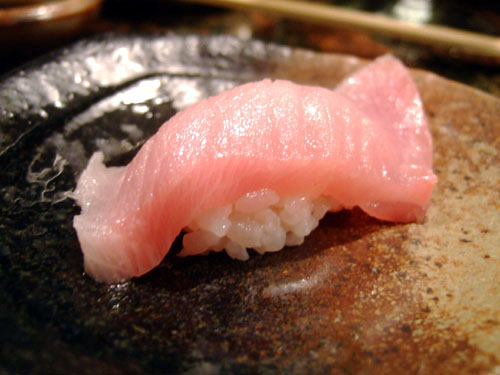
9: Hamachi/Yellowtail [$2.60]
Soy. This was actually a very creamy version of hamachi, but fortunately it wasn't overly unctuous as farmed yellowtail tends to be. Most yellowtail one eats is farm-raised, meaning that the fish don't get as much exercise as their wild counterparts; this results in a fattier, softer, heavier fish. I used to love hamachi when I was a sushi neophyte, but am really beginning to move away from it, especially after experiencing wild yellowtail (i.e. buri).
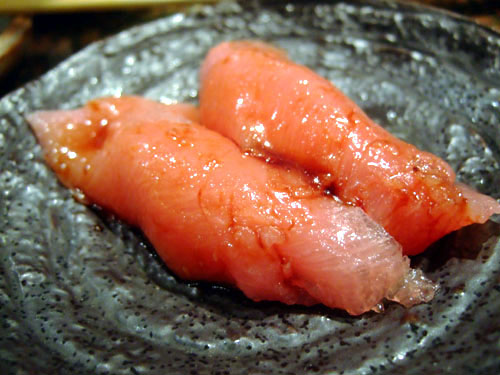
10: Toro/Fatty Tuna [$10.00]
No soy. Every other course of nigiri was served singly, so I'm not sure why two pieces of toro were provided here. In any case, I appreciated the tuna's soft, yielding, no-gristle texture here, but the lack of marbling and oil left me wanting. The sauce was perhaps used a bit too liberally as well. I know this is solid toro, but I just keep comparing it to the simply transcendent toro I had at Kyubey. That piece of toro has "ruined me" so to speak; only Urasawa's comes close.
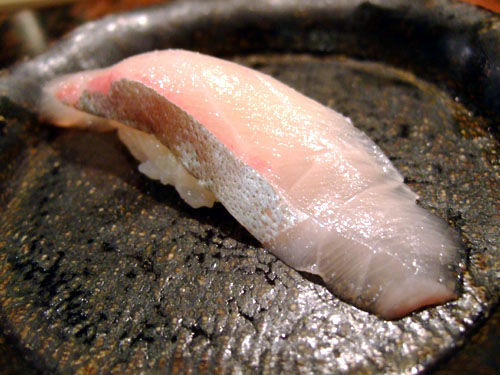
11: Shima Aji/Striped Jack [$3.50]
Soy. What really worked well for me here was the fish's slight crunch coupled with a light oiliness and subtle flavor, accented by wasabi. About the name here, we were told by the waitress that this was "yellowtail skipjack," which struck me as quite odd. Upon researching the nomenclature for a bit, I found that the fish is also known as "yellowjack," which explains the confusion.
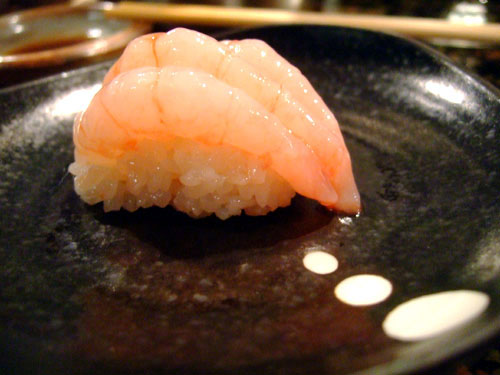
12: Amaebi/Sweet Shrimp [$3.50]
Soy. Sadly, this was disappointing. The shrimp were super creamy, almost mushy, and lacked the crisp snappiness that I like in my amaebi. The flavor was also muted, not sharp or briny enough. One of my dining companions likened this to "shrimp cocktail." The problem, I think, stems from the use of the smaller hokkoku akaebi (Alaskan Pink Shrimp) instead of my preferred botanebi.
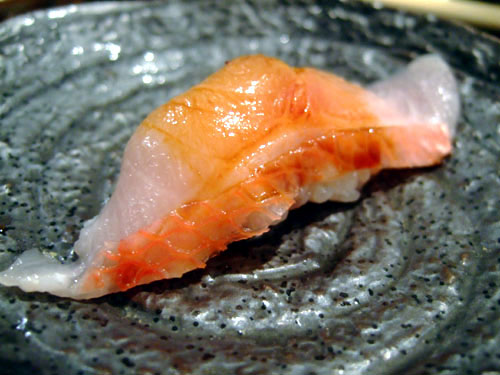
13: Kinmedai/Golden Eye Snapper [$4.50]
No soy. Easily one of the standouts for me. As refreshing as sushi can be, with an ethereal body and silky texture, and very little fat, along with a wasabi finish. I really appreciated the bit of skin left on. Another rarity, I'd had this previously only at Shibucho and Sasabune.
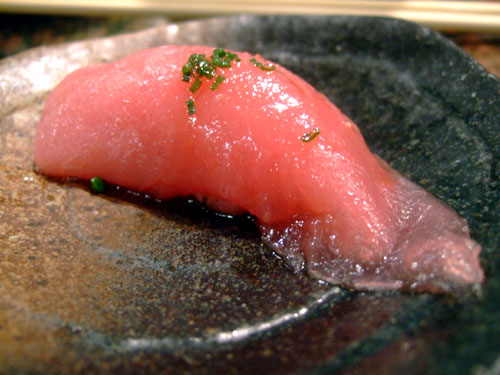
14: Meji Maguro/Baby Tuna [$4.00]
No soy. Now here's something that I don't think I've ever had anywhere else. This was basically young tuna, and was markedly different from its adult brethren. Compared to regular maguro, it was heavier, denser, and chewier (and obviously lighter in color), with a more subtle flavor, highlighted by the soy and citrus. I'd like to see more places offer this.
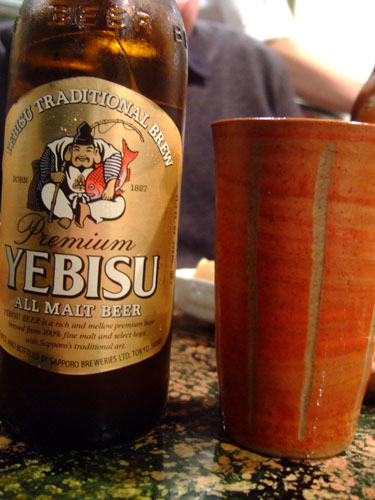
At this time, our sake had run out, so it was time to order a round of Yebisu beer [$6.00]. Though currently owned by Sapporo, Yebisu is one of Japan's oldest brands, and serves as the company's "luxury" beer. Yebisu isn't that common in the States, so I tend to order it whenever available. It's about what you'd expect from a Japanese lager--subtly sweet on the nose, light, a bit hoppy, mildly spicy, and quite bitter. It goes well with sushi.
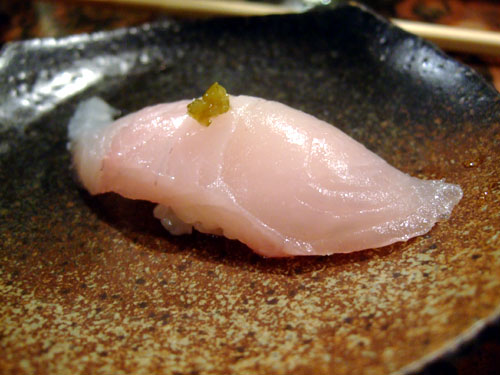
15: Kanpachi/Amberjack [$2.80]
No soy. Like yellowtail, the fish known as amberjack is one whose name changes with its age, in a process termed shusse uo, which roughly means "fish of advancement." Kanpachi is actually the amberjack's most mature stage. In any case, the spiciness of the yuzu kosho really came to the fore here, adding a bit of heat to an otherwise mild-tasting fish. I could see how some might find it distracting though.
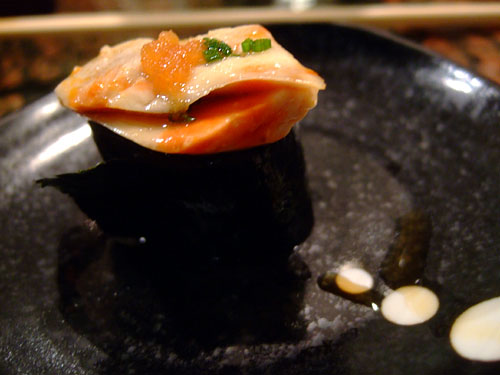
16: Ankimo/Monkfish Liver [$2.50]
This was notable for being the first gunkan-style preparation of ankimo I've seen. The liver was served warm, and topped with momiji oroshi and scallion. These accoutrements served their role deftly, and the whole amalgam was lovely. One of my dining companions, though, felt that the nori was perhaps a bit too dominant in the flavor profile. I, however, quite liked the smokiness of the seaweed.
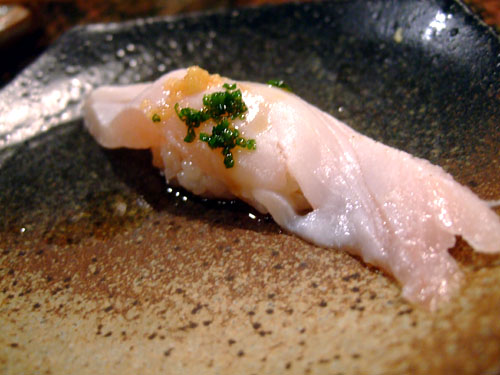
17: Ono/Wahoo [$2.50]
No soy. A fast-swimming game fish popular in Hawaii, ono is a fairly rare selection to find at sushi restaurants. The fish had an interesting texture--soft, gritty, and a bit flaky. The fish was also one of the oiler and richer ones of the night, and had a citrus-tinged, tangy finish thanks to the accompanying sauce. Quite nice.
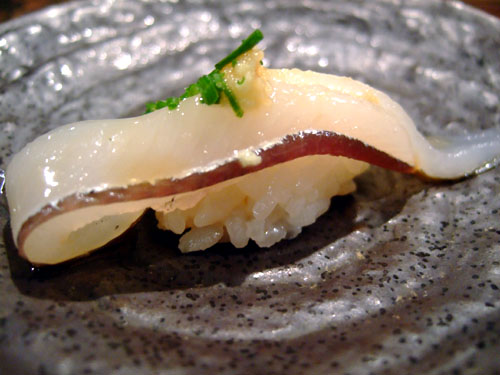
18: Sayori/Needlefish [$3.90]
No soy. The sayori had a great, pleasing crunch to it, along with a mild flavor that really allowed the ginger to take center stage. With its sliver of silver skin, this was arguably the prettiest fish of the night, though the version here didn't have the beauty of the coiled presentation at Urasawa.
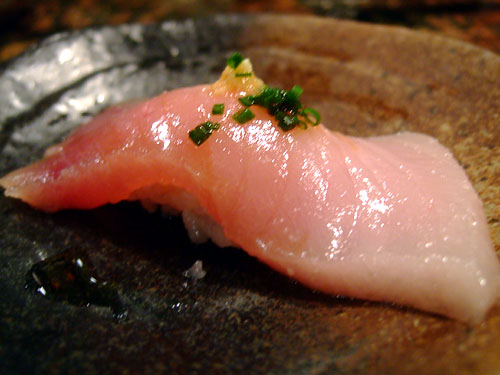
19: Binnaga/Albacore [$2.40]
No soy. This was quite unlike other versions of albacore I'd had before. The fish is generally somewhat firmer and flaky in consistency, while this was soft and creamy. It was almost like a cross between skipjack and yellowtail, with a somewhat middle-of-the-road taste.
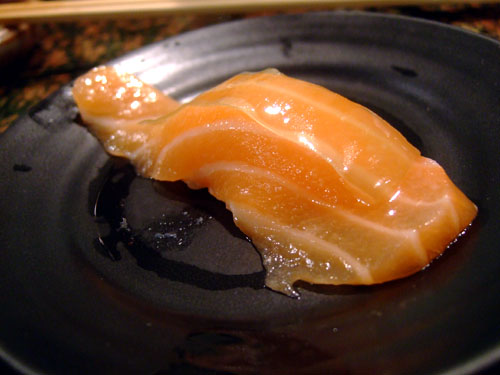
20: Sake/Salmon [$2.40]
Soy. Very tender for salmon, I actually would've preferred this a bit firmer. The fish was tasty by itself, but I found the marinated seaweed topping (battera kombu) far too sweet. It distracted from the natural flavor of the salmon.
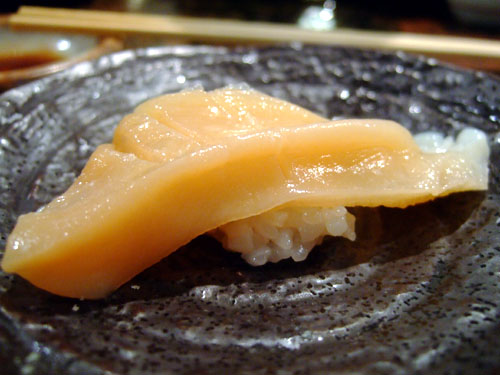
21: Aoyagi/Orange Clam [$2.60]
No soy. This had a perfect crunch to it. Interestingly, the initial flavor was extremely mild for aoyagi, but the clam finished with a strong dose of its signature brininess ("tastes like the ocean"). I would've liked to have seen more of a citrus accompaniment to counterbalance that intensity.
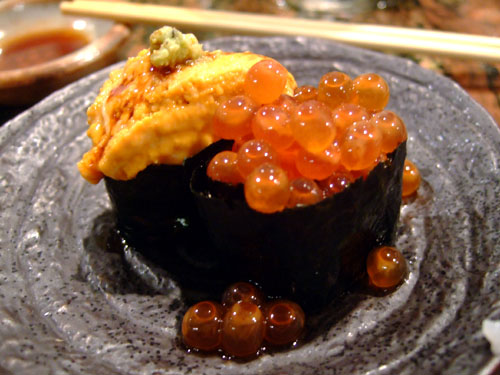
22: Uni/Sea Urchin + Ikura/Salmon Eggs [$7.00]
As with Sushi Sasabune, here we have egg with egg; I'm not sure where the tradition of serving uni and ikura simultaneously comes from. In any case, I first tried the uni, which was a bit cold, though I really enjoyed its mild, creamy flavor and interaction with its nori wrapper. The ikura, meanwhile, was also quite delicious, with the large-ish globules bursting delightfully upon mastication, coating my mouth with their briny, smoky juice.
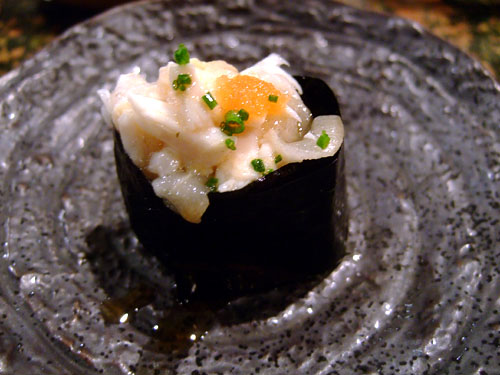
23: Engawa/Halibut Fin [$2.80]
Engawa, or halibut dorsal fin muscle, is another hard to find item. Previously, I'd had it only at Sasabune, where I found it a bit too chewy (not surprising given that it comes from a very active part of the fish). This preparation was quite rich and juicy, but not chewy at all surprisingly; in fact, its consistency was almost like that of cooked fish. Impressive.
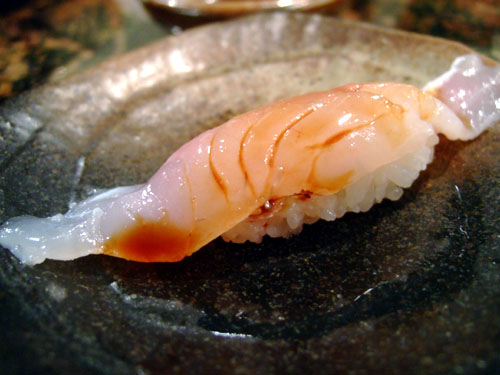
24: Madai/Red Snapper [$2.80]
No soy. Very good, as expected from one of my favorite sushi fish. The flesh here had a somewhat tough, crunchy body to it that was quite pleasing. I noted dominant flavors of wasabi on the attack, which then yielded to a soy-balanced fishiness.
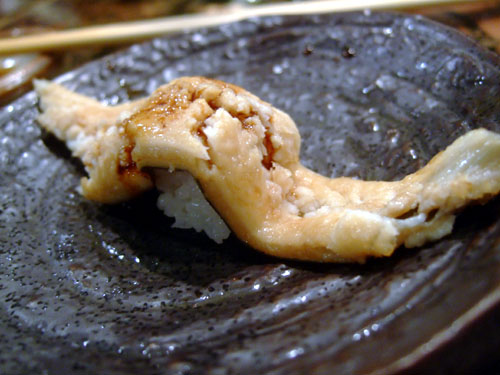
25: Anago/Sea Eel [$4.00]
No soy. A very creamy, yet lean presentation of eel, this was oilier than I expected from anago. It would've preferred a tad less tsume sauce, but nevertheless, I quite like it. This was reminiscent of the anago at Kyubey.
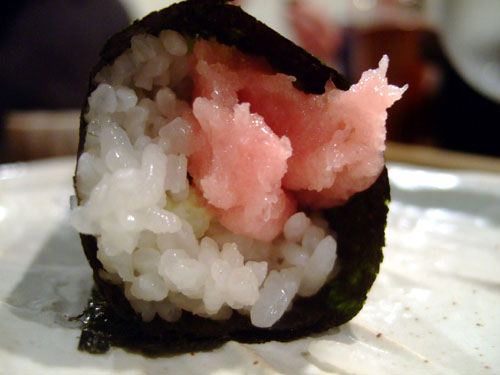
26: Toro Temaki/Fatty Tuna Hand Roll [$8.00]
Soy. I felt that the fish was a bit too soft and mushy here, which resulted in the rice becoming very apparent texture-wise. The wasabi was also very strong here, and tended to overpower the toro in terms of taste. The end result was that the toro seemed a bit wasted here.
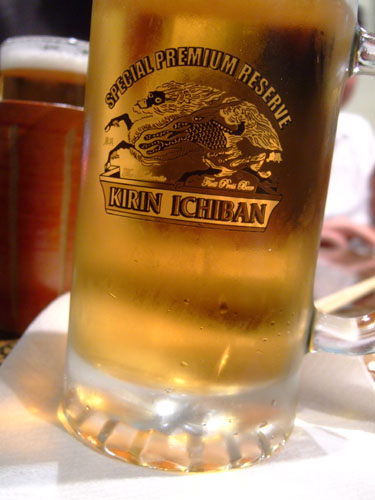
After we'd finished the Yebisus, we ordered a round of Kirin Ichiban Draft [$5.00]. I usually find Kirin to be merely acceptable for a beer, but for some reason, the version here tasted especially good. Perhaps it was because the beer was on draft, or maybe it was the food I paired with it, but this was a pleasant surprise--crisp, hoppy, with a bitter, tangy finish.
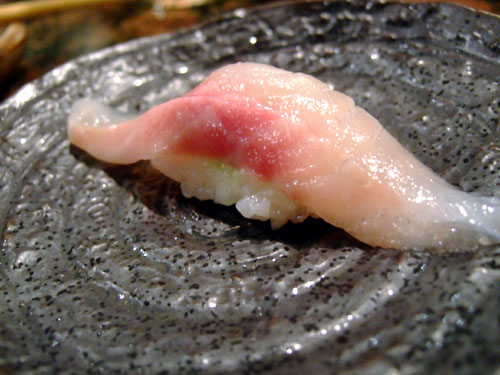
27: Kurodai/Black Snapper [$2.80]
Soy. This was easily one of the best bites of the night. This was my first time having this type of sea bream, a "black snapper" basically. It had a snappy, very slight crunch that was superb. The flesh was lean, clean, and fresh.
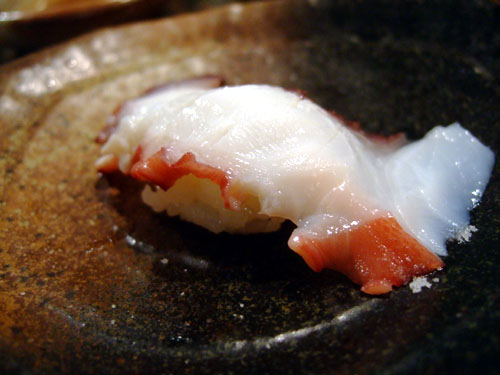
28: Tako/Octopus [$2.20]
No soy. At this point, the omakase was just about over. Keizo asked us if we wanted anything else, and we responded that we wanted any items that we'd not already tried--the octopus and the blue crab hand roll. This was actually a very nice presentation of tako. I liked the fact that it was sliced extra thin, giving it a delightful crunch while preserving tenderness. The octopus' mild flavor was further complemented by a bit of salt sprinkled on top.
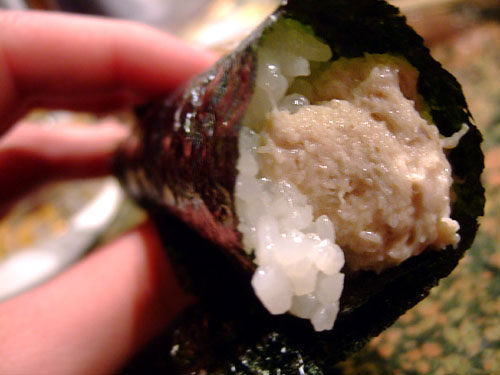
29: Kani Temaki/Blue Crab Hand Roll [$5.00]
The second hand roll of the night, I actually preferred this to the toro temaki. The crab's sweet flavor was obvious here, and was accentuated by the wasabi. This compares quite favorably to the versions I've tried at Echigo, Sushi Sasabune, and Sushi Wasabi.
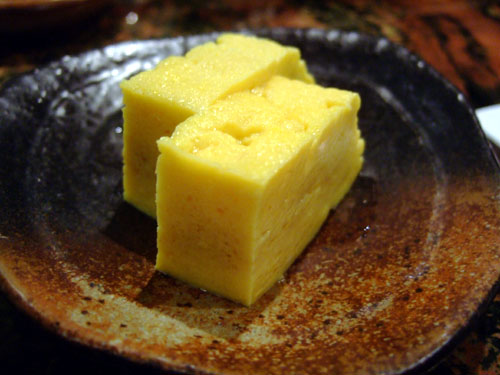
30: Tamago/Egg Omelet [$2.20]
Tamago typically signals the end of a meal. There are many varieties of egg omelet, with this one being cool, sweet, and fluffy, with "hammy" undertones of flavor. It was similar to the tamago at Sushi Wave. Tasty, but nothing special.
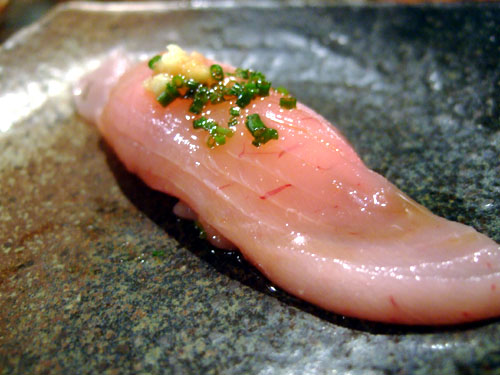
31: Ha-Gatsuo/Skipjack Tuna #2 [$2.80]
After the tamago, Keizo inquired if we wanted any repeats. We decided to go with the skipjack and aji. The skipjack here was very similar to the first piece I had, though this version was a bit more citrus-y, with more dominant ginger notes.
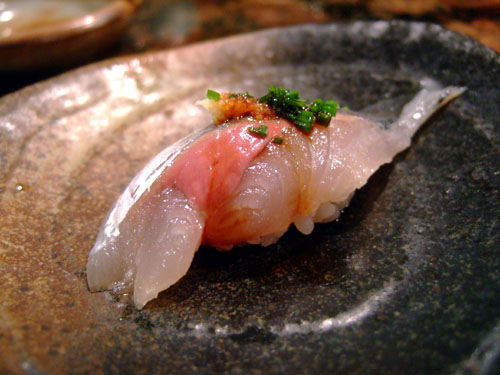
32: Aji/Spanish Mackerel #2 [$2.70]
Unfortunately, the aji wasn't quite as good as before. It was chewier, and definitely fisher, which resulted in a rather metallic taste when paired with the Kirin.
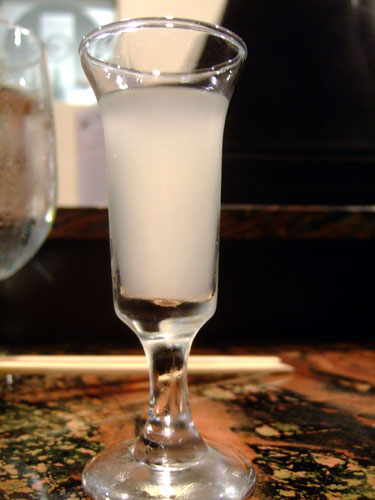
33: Yuzu Juice
Sushi Zo doesn't offer dessert, so meals here are capped off by a shot of yuzu juice. I expected something very tart, but the juice was surprisingly sweet, and delicious. The juice's origin is "secret," and our server wouldn't reveal the source when we inquired about it.
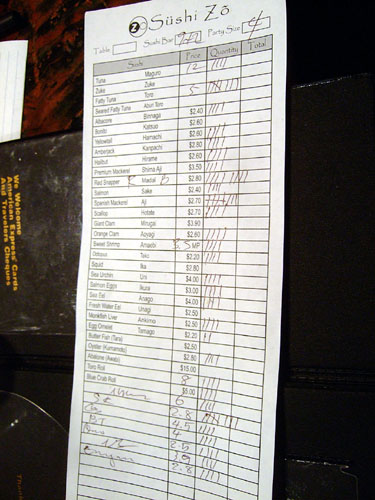
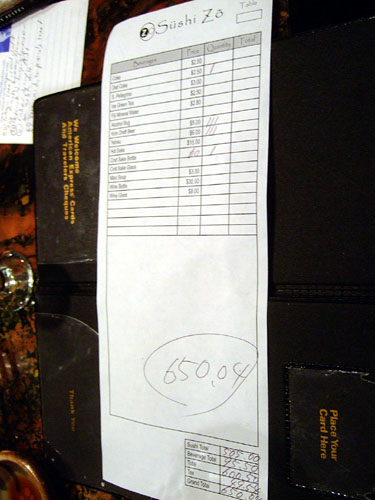
The menu cum bill is shown above; click for larger versions. For a party of four, the end result was about $160 per person (or $125 sans booze), quite reasonable I think given the quality (and quantity) of the food.
Sushi Zo has garnered its share of praise, and perhaps some would say hype. But after eating here, I do feel that such commendation is, for the most part, deserved. Second best? Yeah, I can believe it. Methinks that I need to pay Mori another visit...
Since Sushi Zo didn't offer up a real dessert, we needed something to satisfy our cravings for something sweet. As I mentioned above, the restaurant is located near a Rite-Aid, and thus it was proposed that we go for some Thrifty ice cream. Thrifty, if you recall, was a chain of drug stores in the Western United States, dating back to 1929. It was popular during my childhood years in the 1980's, and was eventually acquired by Rite-Aid in 1998 in a stock-swap merger. Growing up, visits to Thirfty were common, and my favorite thing about the store was the ice cream.
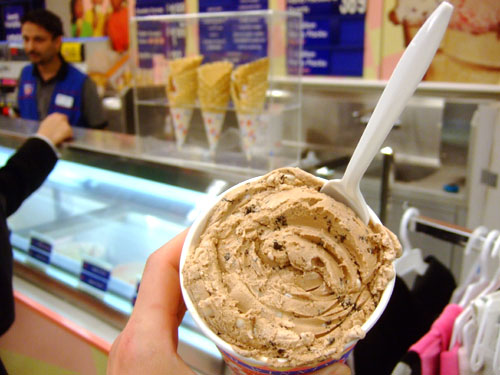
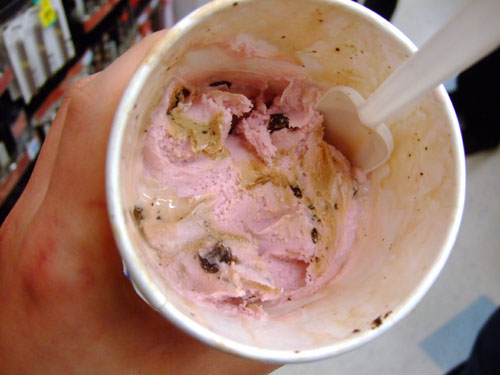
Though traditionally I'd had the ice cream in cone-form, I ended up getting a Hand Packed Pint [$1.99] of Chocolate Malted Crunch and Black Cherry. Chocolate Malted Crunch was easily my favorite back in the day (I used to eat the ice cream first, "saving" the crunchy malt balls), and having not had it for over a decade, was really everything that I remembered it to be--it's amazing how tastes and smells can bring back memories. The Black Cherry was delicious as well, as was the Chocolate Brownie. The perfect close to the evening, Thrifty managed to serve up some great ice cream, along with a dose of old-fashioned nostalgia.
9824 National Blvd, Los Angeles, CA 90034
310.842.3977
www.fooddigger.com/RestaurantDetail.aspx?id=21047 (FoodDigger, restaurant has no web site)
Sat 01/24/2009, 07:00p-09:20p
When asked about the best sushi in Los Angeles, most serious eaters (me included) will respond with Urasawa. In fact, I'm fairly confident that those who don't, simply haven't been. Now, given that Urasawa is at the top of the hierarchy, the question then of who's number two becomes more interesting. A lot of people would say Mori Sushi, some the infamous Sushi Nozawa, or perhaps Sushi Sasabune, maybe even Go's Mart, but the most common answer I hear is the topic of this post: Sushi Zo.
Chef/owner Keizo Seki (most just call him "Keizo") opened Sushi Zo in the middle of 2006, around the time when his daughter was born (a sign of good luck according to Seki-san). Keizo was a student in Osaka when he decided to become a sushi chef, and soon thereafter began an apprenticeship at a sushi restaurant in the Meguro ward of Tokyo. He later immigrated to the US, and spent several years at the dependable but unassuming Hide Sushi before branching out on his own.
Like many sushi greats, Keizo makes his own special shoyu, or soy sauce, and gets much of his raw ingredients shipped from Japan. He also subscribes to the somewhat controversial "warm rice" school, and indeed, on cursory glance, his style does bear a resemblance to the Nozawa/Sasabune way of doing things. No matter, Keizo must be doing something right, as he has drawn legions of followers from amongst the SoCal foodie crowd. It was time for me to see what all the warm fuss was about.


Set in a Rite-Aid- and Vons-anchored strip mall south of Cheviot Hills, Sushi Zo's location doesn't exactly inspire confidence, and would be very easy to overlook. Fortunately however, parking is plentiful and the restaurant is conveniently located for good freeway access.


The interior is fairly contemporary for a sushi bar. No light wood here, but shades of alternating white and argent. From what I hear, the bar (which seats about a dozen) is omakase only, and on Fridays and Saturdays, the entire restaurant is. Not that you should order anything else but omakase...


I was seated in the corner of the L-shaped bar, nearly right in front of Keizo. Once seated, our waitress warned us that the place served traditional sushi only and, once we agreed to that, asked about any food restrictions we might have ("I'll eat anything" is the correct answer here). There were three people behind the counter, and interestingly, though Keizo was right in front of us, he didn't actually place the individual pieces of sushi before us, instead, leaving that task to the waitresses (who also instructed us on the use of soy, e.g. "no soy" or "little soy"). Keizo is a man of few words, as he remained silent throughout most of the night, only gradually opening up towards the end of the experience.


Placed on the bar were these placards bearing sushi-eating instructions and etiquette; click for larger versions. It's good advice, and though I don't see Keizo as being terribly strict, I have heard anecdotes of him kicking people out for trying to order California rolls and such, and also for talking on cell phones.


The drink menu is unfortunately small--just a couple beers, a solitary wine, and a handful of sakes are available. Some sparkling wine would be a welcomed addition for me.

Given the limited selection, we decided to kick things off with sake: a bottle of Tsukasabotan Tokubetsu Junmai "Senchu Hassaku" ("Eight Point Plan") [$60.00]. Founded in 1603, the producer, Tsukasa Botan, is one of the oldest breweries in Kochi prefecture, on Shikoku island. The sake here is their mid-end selection, and is made from Yamada Nishiki rice polished to roughly 57%, resulting in an alcohol content in the 15.5% range. I noted a light airiness to the drink, with a mildly sweet and creamy aroma leading to a dry, yet fruity palate. Not overly complex, but effective, with a smooth, straightforward finish.

Here we see the place setting at the beginning of the meal. The gari, or ginger, was among the best I've tried--crisp, with a bracing tang that effectively reset the palate between courses.

1: Kumamoto Kaki/Oyster [$2.80]
I've always been fond of Kumamotos, and this dish reaffirmed their status as my oyster of choice. The example here, heightened by the application of ponzu, momiji oroshi and scallion, was clean, light, crisp, and tangy, with a pleasant, lingering brininess on the finish.

2: Maguro/Tuna Sashimi [$12.00]
Next, a simple sashimi course of bluefin tuna. This could've turned out very boring (as tuna tends to), but was actually a pleasant surprise. The maguro had a very pleasing texture to it--tender, yet with a bit of chew to it, and was suitably oily. The light sauce added complexity upon first taste, while the dollops of wasabi gave the sashimi a biting, spicy finish.

3: Ika/Squid Noodle with Uni/Sea Urchin [$6.00]
Now this was an interesting dish. What we have is squid "noodles" smothered in a creamy sea urchin roe "sauce." The uni really came to the fore here, with the squid taking a backseat. In fact, had I not been told of the squid, I could've easily mistaken the "noodles" for actual noodles, as they were very soft and not chewy at all.

4: Awabi/Baby Abalone [$25.00]
The abalone itself was rather mild, with just a hint of brininess, and had a crunchy, slightly rubbery consistency. It wasn't particularly exciting on its own, but really opened up with the use of yuzu kosho ("yuzu and pepper"), a condiment made from yuzu zest, chili peppers, and salt. It added an absolutely fascinating spicy yet salty yet sour kick to the abalone that really took the dish to another level.

5: Hirame/Halibut [$2.60]
No soy. The hirame was a nice way to start off the nigiri portion of the meal. Halibut isn't particularly strong tasting, and initially, all I got was a sort of general fishiness spruced up by a very slight citrus-y twang, followed up by a wasabi kick. Gorgeous texture on this one.

6: Hotate/Scallop [$2.70]
Little soy. A fantastic soft, yet firm texture along with a wonderfully delicate, sweet scallop flavor combined here to form one of the best preparations of scallop sushi I've had.

7: Aji/Spanish Mackerel [$2.70]
No soy. Aji is quickly becoming one of my favorite fishes, and this example shows why. There was just enough of that signature mackerel fishiness to make this interesting, but it didn't overpower like it sometimes does. Instead, the flavor was complemented perfectly by the tart sauce and strong ginger-y finish.

8: Ha-Gatsuo/Skipjack Tuna [$2.80]
No soy. Skipjack is a relatively rare fish to find; I've only had it before at Echigo and Urasawa. I wish it were more common, as it turned out to be one of the highlights of the evening. Much more fascinating than regular tuna, the fish had a somewhat softer, richer texture. The taste initially was dominated by ponzu and ginger, but gradually gave way to reveal the true nature of the fish.

9: Hamachi/Yellowtail [$2.60]
Soy. This was actually a very creamy version of hamachi, but fortunately it wasn't overly unctuous as farmed yellowtail tends to be. Most yellowtail one eats is farm-raised, meaning that the fish don't get as much exercise as their wild counterparts; this results in a fattier, softer, heavier fish. I used to love hamachi when I was a sushi neophyte, but am really beginning to move away from it, especially after experiencing wild yellowtail (i.e. buri).

10: Toro/Fatty Tuna [$10.00]
No soy. Every other course of nigiri was served singly, so I'm not sure why two pieces of toro were provided here. In any case, I appreciated the tuna's soft, yielding, no-gristle texture here, but the lack of marbling and oil left me wanting. The sauce was perhaps used a bit too liberally as well. I know this is solid toro, but I just keep comparing it to the simply transcendent toro I had at Kyubey. That piece of toro has "ruined me" so to speak; only Urasawa's comes close.

11: Shima Aji/Striped Jack [$3.50]
Soy. What really worked well for me here was the fish's slight crunch coupled with a light oiliness and subtle flavor, accented by wasabi. About the name here, we were told by the waitress that this was "yellowtail skipjack," which struck me as quite odd. Upon researching the nomenclature for a bit, I found that the fish is also known as "yellowjack," which explains the confusion.

12: Amaebi/Sweet Shrimp [$3.50]
Soy. Sadly, this was disappointing. The shrimp were super creamy, almost mushy, and lacked the crisp snappiness that I like in my amaebi. The flavor was also muted, not sharp or briny enough. One of my dining companions likened this to "shrimp cocktail." The problem, I think, stems from the use of the smaller hokkoku akaebi (Alaskan Pink Shrimp) instead of my preferred botanebi.

13: Kinmedai/Golden Eye Snapper [$4.50]
No soy. Easily one of the standouts for me. As refreshing as sushi can be, with an ethereal body and silky texture, and very little fat, along with a wasabi finish. I really appreciated the bit of skin left on. Another rarity, I'd had this previously only at Shibucho and Sasabune.

14: Meji Maguro/Baby Tuna [$4.00]
No soy. Now here's something that I don't think I've ever had anywhere else. This was basically young tuna, and was markedly different from its adult brethren. Compared to regular maguro, it was heavier, denser, and chewier (and obviously lighter in color), with a more subtle flavor, highlighted by the soy and citrus. I'd like to see more places offer this.

At this time, our sake had run out, so it was time to order a round of Yebisu beer [$6.00]. Though currently owned by Sapporo, Yebisu is one of Japan's oldest brands, and serves as the company's "luxury" beer. Yebisu isn't that common in the States, so I tend to order it whenever available. It's about what you'd expect from a Japanese lager--subtly sweet on the nose, light, a bit hoppy, mildly spicy, and quite bitter. It goes well with sushi.

15: Kanpachi/Amberjack [$2.80]
No soy. Like yellowtail, the fish known as amberjack is one whose name changes with its age, in a process termed shusse uo, which roughly means "fish of advancement." Kanpachi is actually the amberjack's most mature stage. In any case, the spiciness of the yuzu kosho really came to the fore here, adding a bit of heat to an otherwise mild-tasting fish. I could see how some might find it distracting though.

16: Ankimo/Monkfish Liver [$2.50]
This was notable for being the first gunkan-style preparation of ankimo I've seen. The liver was served warm, and topped with momiji oroshi and scallion. These accoutrements served their role deftly, and the whole amalgam was lovely. One of my dining companions, though, felt that the nori was perhaps a bit too dominant in the flavor profile. I, however, quite liked the smokiness of the seaweed.

17: Ono/Wahoo [$2.50]
No soy. A fast-swimming game fish popular in Hawaii, ono is a fairly rare selection to find at sushi restaurants. The fish had an interesting texture--soft, gritty, and a bit flaky. The fish was also one of the oiler and richer ones of the night, and had a citrus-tinged, tangy finish thanks to the accompanying sauce. Quite nice.

18: Sayori/Needlefish [$3.90]
No soy. The sayori had a great, pleasing crunch to it, along with a mild flavor that really allowed the ginger to take center stage. With its sliver of silver skin, this was arguably the prettiest fish of the night, though the version here didn't have the beauty of the coiled presentation at Urasawa.

19: Binnaga/Albacore [$2.40]
No soy. This was quite unlike other versions of albacore I'd had before. The fish is generally somewhat firmer and flaky in consistency, while this was soft and creamy. It was almost like a cross between skipjack and yellowtail, with a somewhat middle-of-the-road taste.

20: Sake/Salmon [$2.40]
Soy. Very tender for salmon, I actually would've preferred this a bit firmer. The fish was tasty by itself, but I found the marinated seaweed topping (battera kombu) far too sweet. It distracted from the natural flavor of the salmon.

21: Aoyagi/Orange Clam [$2.60]
No soy. This had a perfect crunch to it. Interestingly, the initial flavor was extremely mild for aoyagi, but the clam finished with a strong dose of its signature brininess ("tastes like the ocean"). I would've liked to have seen more of a citrus accompaniment to counterbalance that intensity.

22: Uni/Sea Urchin + Ikura/Salmon Eggs [$7.00]
As with Sushi Sasabune, here we have egg with egg; I'm not sure where the tradition of serving uni and ikura simultaneously comes from. In any case, I first tried the uni, which was a bit cold, though I really enjoyed its mild, creamy flavor and interaction with its nori wrapper. The ikura, meanwhile, was also quite delicious, with the large-ish globules bursting delightfully upon mastication, coating my mouth with their briny, smoky juice.

23: Engawa/Halibut Fin [$2.80]
Engawa, or halibut dorsal fin muscle, is another hard to find item. Previously, I'd had it only at Sasabune, where I found it a bit too chewy (not surprising given that it comes from a very active part of the fish). This preparation was quite rich and juicy, but not chewy at all surprisingly; in fact, its consistency was almost like that of cooked fish. Impressive.

24: Madai/Red Snapper [$2.80]
No soy. Very good, as expected from one of my favorite sushi fish. The flesh here had a somewhat tough, crunchy body to it that was quite pleasing. I noted dominant flavors of wasabi on the attack, which then yielded to a soy-balanced fishiness.

25: Anago/Sea Eel [$4.00]
No soy. A very creamy, yet lean presentation of eel, this was oilier than I expected from anago. It would've preferred a tad less tsume sauce, but nevertheless, I quite like it. This was reminiscent of the anago at Kyubey.

26: Toro Temaki/Fatty Tuna Hand Roll [$8.00]
Soy. I felt that the fish was a bit too soft and mushy here, which resulted in the rice becoming very apparent texture-wise. The wasabi was also very strong here, and tended to overpower the toro in terms of taste. The end result was that the toro seemed a bit wasted here.

After we'd finished the Yebisus, we ordered a round of Kirin Ichiban Draft [$5.00]. I usually find Kirin to be merely acceptable for a beer, but for some reason, the version here tasted especially good. Perhaps it was because the beer was on draft, or maybe it was the food I paired with it, but this was a pleasant surprise--crisp, hoppy, with a bitter, tangy finish.

27: Kurodai/Black Snapper [$2.80]
Soy. This was easily one of the best bites of the night. This was my first time having this type of sea bream, a "black snapper" basically. It had a snappy, very slight crunch that was superb. The flesh was lean, clean, and fresh.

28: Tako/Octopus [$2.20]
No soy. At this point, the omakase was just about over. Keizo asked us if we wanted anything else, and we responded that we wanted any items that we'd not already tried--the octopus and the blue crab hand roll. This was actually a very nice presentation of tako. I liked the fact that it was sliced extra thin, giving it a delightful crunch while preserving tenderness. The octopus' mild flavor was further complemented by a bit of salt sprinkled on top.

29: Kani Temaki/Blue Crab Hand Roll [$5.00]
The second hand roll of the night, I actually preferred this to the toro temaki. The crab's sweet flavor was obvious here, and was accentuated by the wasabi. This compares quite favorably to the versions I've tried at Echigo, Sushi Sasabune, and Sushi Wasabi.

30: Tamago/Egg Omelet [$2.20]
Tamago typically signals the end of a meal. There are many varieties of egg omelet, with this one being cool, sweet, and fluffy, with "hammy" undertones of flavor. It was similar to the tamago at Sushi Wave. Tasty, but nothing special.

31: Ha-Gatsuo/Skipjack Tuna #2 [$2.80]
After the tamago, Keizo inquired if we wanted any repeats. We decided to go with the skipjack and aji. The skipjack here was very similar to the first piece I had, though this version was a bit more citrus-y, with more dominant ginger notes.

32: Aji/Spanish Mackerel #2 [$2.70]
Unfortunately, the aji wasn't quite as good as before. It was chewier, and definitely fisher, which resulted in a rather metallic taste when paired with the Kirin.

33: Yuzu Juice
Sushi Zo doesn't offer dessert, so meals here are capped off by a shot of yuzu juice. I expected something very tart, but the juice was surprisingly sweet, and delicious. The juice's origin is "secret," and our server wouldn't reveal the source when we inquired about it.


The menu cum bill is shown above; click for larger versions. For a party of four, the end result was about $160 per person (or $125 sans booze), quite reasonable I think given the quality (and quantity) of the food.
Sushi Zo has garnered its share of praise, and perhaps some would say hype. But after eating here, I do feel that such commendation is, for the most part, deserved. Second best? Yeah, I can believe it. Methinks that I need to pay Mori another visit...
Since Sushi Zo didn't offer up a real dessert, we needed something to satisfy our cravings for something sweet. As I mentioned above, the restaurant is located near a Rite-Aid, and thus it was proposed that we go for some Thrifty ice cream. Thrifty, if you recall, was a chain of drug stores in the Western United States, dating back to 1929. It was popular during my childhood years in the 1980's, and was eventually acquired by Rite-Aid in 1998 in a stock-swap merger. Growing up, visits to Thirfty were common, and my favorite thing about the store was the ice cream.


Though traditionally I'd had the ice cream in cone-form, I ended up getting a Hand Packed Pint [$1.99] of Chocolate Malted Crunch and Black Cherry. Chocolate Malted Crunch was easily my favorite back in the day (I used to eat the ice cream first, "saving" the crunchy malt balls), and having not had it for over a decade, was really everything that I remembered it to be--it's amazing how tastes and smells can bring back memories. The Black Cherry was delicious as well, as was the Chocolate Brownie. The perfect close to the evening, Thrifty managed to serve up some great ice cream, along with a dose of old-fashioned nostalgia.
60 Comments:
EW.
would people actually say sasabune was #2?!?! which people?!
i wouldn't trust these people.
kevin,
i live very nearby to sushi zo but never been. i know the taco place next door is horrible though. great descriptions for each piece. the fish looked so fresh and impressive. you are still able to order individually correct if you want right?
paul
The Kumamoto Kaki/Oyster looks amazing. Great photos (as usual). : )
This comment has been removed by the author.
Urasawa is way overrated (and yes overpriced)
Sasabune was never the same once it moved to Wilshire blvd.
This place looks good -- need to check it out
I am drooling all over these pics! I can't stand the traffic in LA but if I ever return, I sure want to eat here.
Fantastic pics, per usual. I really wish all my travels to LA weren't with non-sushi people. :)
Sarah: Plenty of people, especially on CH! Now I'm not saying I necessarily agree... ;)
Paul: I guess there's a reason why the taco place was completely empty. We were only able to order individually after the omakase was done. If you do want to do a la carte, sitting at a table is your best bet.
MyLasteBite: Thanks! The Kumamotos were excellent, as expected. They really are my favorite now.
radman123: Can you give me a place in LA that's better than Urasawa? I'd very much be interested! But in any case, do check out Sushi Zo and let us know what you think.
Jessica: So what places in NY do you like for sushi? Unfortunately I didn't get to try any on my visit over the holidays. And don't get me started on the traffic...
uhockey: That's unfortunate, as LA is arguably the place for sushi in this country. How's the sushi scene over in Ohio?
Kevin: Your blog is true food voyeurism. You are right, we need to identify #2 & #3 spots in LA. Add to your list of next visits: The Hump at the Santa Monica airport. You should fly or take a helicopter from Orange County and pull up to the restaurant and walk right up. The experience is not to be missed, and I think it might have the ultimate ambiance which pushes the envelope. How many restuarants have you ever landed at? I think it might be a spectacular experience for you.
I have to say the ambiance of Zo made me hesitate a little. The idea of mandatory Omakase when you are not sitting at the sushi bar?!!! I have never heard that before other than Urasawa. That is a new one for me.
There was a paucity of cooked dishes which I think takes the omakase experience down a notch. I wanted to see what the chef could do with a torch or in the kitchen. Morimoto in Philadelphia will dazzle doing it all, for example. Is Keizo in that category of Masa, Morimoto, Nobu Matsuhisa, Urasawa-San. You did not seem to miss themat Zo but in retrospect? Where's the Beef? (Saga Beef, Seared Toro, etc.) Would it have mattered had you not been sitting with Keizo?
As always, people (including me) are living vicariously through your site. Although, Sushi Zo is close enough that I may go there yet. Saving up for the U, so I will have to put off Zo indefinitely. I had no idea that Keizo used to work at Hide, considering the sushi experience there is not all that creative.
Evan: I haven't heard great things about The Hump. The consensus, it seems, is that for the price, you're better off at Urasawa.
That being said, I do agree that a few more cooked dishes at Sushi Zo would step things up a notch.
If we restrict things to sushi, I'd put Sushi Zo on the second tier, below the likes of Urasawa and Masa. I can't speak of Morimoto, but I have never been impressed with the sushi at Nobu/Matsuhisa.
Aaron: Sushi Zo won't seem quite as special after you've experienced Urasawa. ;)
nice post kevin!
the hotate is usually better here than most places as is the aji (less fishy), although the toro is often disappointing =(
as for baby tuna..i've often had it at sasabune as a sashimi starter since i dislike the albacore one =P
for some reason i had a terrible meal at mori..i wonder if it is worth it to give it another go.
i'm surprised keizo didn't comment on you taking photos before eating!
grace
Thanks Grace. Keizo didn't really comment on anything the entire night, though I was a bit concerned that photos wouldn't be allowed. I would've appreciated some banter, but oh well.
As for Mori, I plan on giving it another try sometime. I remember the food being quite good, but the experience was ruined by a photography ban at the time.
I thought I posted my comment but it didn't go through: I'm all about chocolate malted crunch, been eating that since I was young. Nice choice with the pint-size. For $125 it looks like a great amount of food.
Indeed, at $125, the cost of the meal was surprisingly reasonable.
Glad to see another Chocolate Malted Crunch fan--perhaps it's something about being children of the 80's. Disturbingly, in hindsight, I think I could've done the quart...
Mmmm the pictures make me hungry! ^_^ I went here a while ago, still lazy about posting, but the fish was good. The pictures look amazing too! I think Sushi Zo is much better than K-Zo (http://www.kats9lives.com/2008/12/k-zo-you-can-always-have-more-sushi.html) and Mori Sushi.
This comment has been removed by the author.
Thanks, I was waiting for you to come here. I'll have to bring my mom here soon.. after I show her your pictures so she'll believe me it's good.
I am truly a fan of your blog!! It's the BEST foodie blog ever!
Kat: K-Zo is not affiliated with Sushi Zo like many people think, despite the name. It looks pretty decent though from your post. The food seems a bit less traditional perhaps.
As for Mori, I could see Sushi Zo being better, but I think I need to give Mori another shot. It's been a long time since my last visit, and that experience was tainted by a photography ban.
Jen: Thanks! Where else are you waiting for?
Great review and pics as always. As a side question, what camera/lens are you using for your food pics??
As with Aaron, I'm saving up for the U in March, but I'm so tempted to eat at Zo as an "amuse bouche" to the U. I have a feeling after eating there, no other sushi in the US will top the experience.
Thanks Danny. I use a Fujifilm FinePix F30, a compact camera well known for its low light prowess. I shoot pretty much everything at 8mm(36mm equivalent)/f2.8, on macro mode (5cm minimum focusing distance).
Zo would be quite an "amuse," but it may not be a bad idea, as the experience won't seem quite as special after Urasawa. The only place that I think could top Urasawa (in the US) is Masa in NY.
In any case, I'll see you on the 28th!
hi Kevin,
Glad to see you made it to Zo. When I went, the Hotate was one of my favorites as well. I agree the overall quality of the fish is up there, a few notches below Urasawa. However, my biggest complaint is that one of the sauces he uses has way too much ginger which for me overpowers the fish. You alluded to this sauce a bit, but sounds as if you liked it. I also thought the salmon was too sweet.
Great review!!
Thanks! I could see how one could find the ginger a bit too overwhelming. It was certainly present, and even dominant, in a few of the courses. As for the salmon, I think it was the marinated seaweed that was the problem.
where u been Kevin? - 10 days since a new posting! very unlike you
I know, I know. Unfortunately, I've been quite busy as of late, and that's taken a toll on my blogging time. The next one will be Sona.
"I have heard anecdotes of him kicking people out for trying to order California rolls and such, and also for talking on cell phones."
Love it, love it!!
How much does it cost per person for the Omakase? It's a set amount correct? Thanks!
"the end result was about $160 per person (or $125 sans booze)"
It's not set per se. Basically, he just goes until you tell him to stop, and the prices are as stated in the menu (see photo). We had him go through everything he had, but you can get out for less if you consume less.
An excellent review of Sushi Zo. You've been to Mori Sushi right? (I think I read somewhere that you did). You should go back and give them another chance. I know you avoided going because of their ban on taking pictures, but recently they started letting people bring cameras.
Thanks Frank. Yes you are correct about Mori Sushi. I went a couple years ago but haven't been back due to the photo policy. I know that this rule has been loosened in recent times, so Mori's definitely on my to-eat list now.
Hey Kevin..I just set up a reservation for Sushi Zo on Thursday! I'm going with a girl *wink wink nudge nudge* but was wondering if I'm going to get a pwned by Keizo for not being a sushi aficionado. I am not a sushi noob but I'm not pro like you. It's also my first time ordering omakase ($$$$$).
Since it's omakase, you won't be doing much ordering. And as long as you eat everything, there should be no problem. Keizo-san doesn't talk much anyway, so you'll be focusing more on your date than conversing with him.
Kevin,
A fabulous review of Zo! I'd be curious to hear what you'd think of Sushi Nishi-ya in Glendale. It really surprised me with its quality, but I haven't seen a lot of reviews of it online, even though I'd say the experience was comparable to Sushi Zo (perhaps even better, since the chef welcomes interaction and questions).
Thanks Shannon. I'll admit I don't make it out to the Glendale area too often, but I just checked out Nishi-ya and it looks promising; I like the fact that it's omakase only, with none of those stupid rolls! It's on my list for next time I'm up there.
great pics and review.. been hearing a lot about sushi zo and scoping out places to eat during my my trip back... drooling over your archives now.
btw- i haven't had chocolate malted krunch in a looong time. i think i need to get a pint
Thanks Joan. Definitely try out Zo if you're in the mood for top-notch sushi (and don't want to spend Urasawa money).
Good call on the Chocolate Malted Crunch. ;)
kevin, would you say zo is better than go's mart?
ling
Ling, from a purist perspective, I'd say so. Go's is more exciting though.
Ah...on the sake/ salmon you had it was the battera kombu again. I have had it this way and make it when asked. You're correct it is too sweet, really, for the flavors of good salmon or salmon belly. This kombu is typically marinated in amazu...rice vinegar, dashi, and sugar. It pairs best with "hikarimono".
Thanks again Brent. I'll go ahead and update the post. ;)
I think Keizo has been instructed to be so serious and quiet. I got to know him fairly well at Hide and we always talked about the Lakers and everything going on. At Zo, he simply acknowledged that he remembered me, and that was it. I found it a bit odd, but do agree that Zo is phenomenal, nearly as good as Urasawa from a pure sushi point of view (U takes the lead as far as overall experience though).
That's an interesting observation. Who do you think instructed him to tone it down? And why?
And yes, Zo may very well be #2 behind Urasawa.
That made my mouth water! What an excellent blog. How on earth did you keep track and remember all those flavors/names, names to what fish.. etc.. jot notes? mental? or you are just very well palate knowledged? I'm trying to get my own blog started..but kinda of lazy. tips?
Thanks Victoria. For a meal of this magnitude, I'll bring a notepad with me and write everything down as I taste. It makes writing the post much easier. Plus, having the photos to refer to helps jog my memory. ;)
Kevin,
Love your blog Good stuff. Sushi Zo isn't even the best sushi place in the area. Hiko Sushi on National at Sawtelle is better.
I've never been impressed with Mori, but I've had nothing but good meals at The Hump. Little known secret, eat at Typhoon and if you ask nicely they will bring you the Hump's menu as well to order from.
One more thing.
Sushi at Chaya in Venice can sometimes be spectacular.
When it's a special always order it.
Haven't been to Hiko, but it looks like it'd be good. Better than Zo? A lofty claim indeed--you're going against the consensus on that one! Is Hiko your top sushi place in LA?
Regarding Mori, I had a good meal there years ago, but haven't returned because I got into a tiff with the staff regarding photo-taking. Haven't been to The Hump or Chaya.
You have to go to Typhoon which is the restaurant one floor below The Hump. They have a eclectic menu(http://www.typhoon.biz/menus/dinnermenu.html). If you get there early (before 7), you may ask they will bring you the Hump's sushi menu as well. They get many of their items flown in from Japan 2-3 times a week. Same person owns both restaurants. At its best The Hump is my favorite sushi place, but Hiko is more consistent. Only top place I haven't been to is Urasawa.
Why didn't Mori let you take pictures?
Stan, unfortunately I don't know the exact reason behind the photography ban. They just asked me to stop taking photos, and I complied. From reading other blogs though, it looks like the ban has since been lifted.
Hellow!
I love your site, It is a pleasure to visit.
I have added your site to my site.
Please link my site to your site.
Thank you!
I reviewed my unpleasant experience at Sushi Zo here:http://www.yelp.com/user_details_reviews_self?userid=layajWhGLU22kjy3XJk8iA
If you are ever back in Culver City, make sure to try K-Zo. I have not been to Urasawa yet, but so far K-Zo is for me the epitome of creative, varied and absolutely delectable omakase.
Some pics here:
http://picasaweb.google.com/kmannens/OmakaseKZoOctober2010?authkey=Gv1sRgCIeO093DrKjkggE#
http://picasaweb.google.com/kmannens/KZoCulverCityCA?authkey=Gv1sRgCI_Wg4y2xo-qwwE#
seafood: Sorry, I don't do links, as you can see.
Kevin: I'm not sure what type of "culinary imagination and artistry" you're expecting though. I've definitely heard good things about K-Zo, and Urasawa himself even recommended it. It's a bit more nontraditional however, and I find that most sushi places follow the mantra demonstrated here, focusing on rice and fish. That being said, you might want to consdier Go's Mart or maybe Nozomi for a more creative spin.
I'm not sure what type of "culinary imagination and artistry" you're expecting though. --> I was expecting a more varied omakase; not just sushi/sashimi, but also warm dishes (maybe even some hotpot). Like at Urasawa, K-Zo, Izayoi, Irori. Mixing it up not only prevents palate exhaustion, but also illustrates the chef's ability to prepare outside the box.
I understand. I think it depends on what you're looking for. I'm actually ok with the "sushi only" philosophy of Zo and many other places, but I do appreciate it when the chef mixes things up a bit. Also, Mori is also another place you should try if you haven't already.
Mori is also another place you should try if you haven't already. --> Do you know if they have lifted the photography ban you mentioned in one of your reviews? I refuse to go to places that make me feel uncomfortable for documenting my culinary exploits.
I've seen photos from after my visit, so I believe they're no longer as strict about photogrpahy. Check out all the photos on Yelp, for example.
Amazing review as always..$160/person seem fair enough..and i see at the bill u have the abalones(awabi)for free there ;)
Hmm, I can't seem to find the abalone on there either. I'm not complaining. ;)
watched jiro dreams of sushi and inspired by that movie, friends and i wanted to go get some sushi and everyone agreed on zo.
it was really good. they have a bit more extensive drinks list now, and we ordered one bottle of sake ($70), and the total bill came out to $150/pp...but you def had more dishes than we did (maybe inflation?)
anyways, the only misses for us were the amaebi for the exact reason you cited, and tamago.
we really liked their ginger, although it's a bit sweeter than i'm used to. we kept asking for more, so the waitress brought us a big dish with ginger piled high.
and their soy sauce...tastes like he used bonito flakes. hahahaha.
and some of the sushi that had truffle salt. BOMB!
Thanks for the report back Daniel. Sounds like Zo hasn't changed much, except for the prices perhaps. ;)
Post a Comment
Subscribe to Post Comments [Atom]
<< Home